Breitling vs Rolex: Timeless Luxury Face-Off
Rolex and Breitling stand as titans in the luxury watch industry, each with a unique heritage and appeal. This comparison delves into their distinct strengths, from the timeless elegance of Rolex watches to the aviation-inspired innovation of Breitling watches. Whether you're a seasoned collector or new to luxury horology, understanding these iconic brands will guide you toward a choice that perfectly suits your style and needs.
Brand Heritage and Legacy
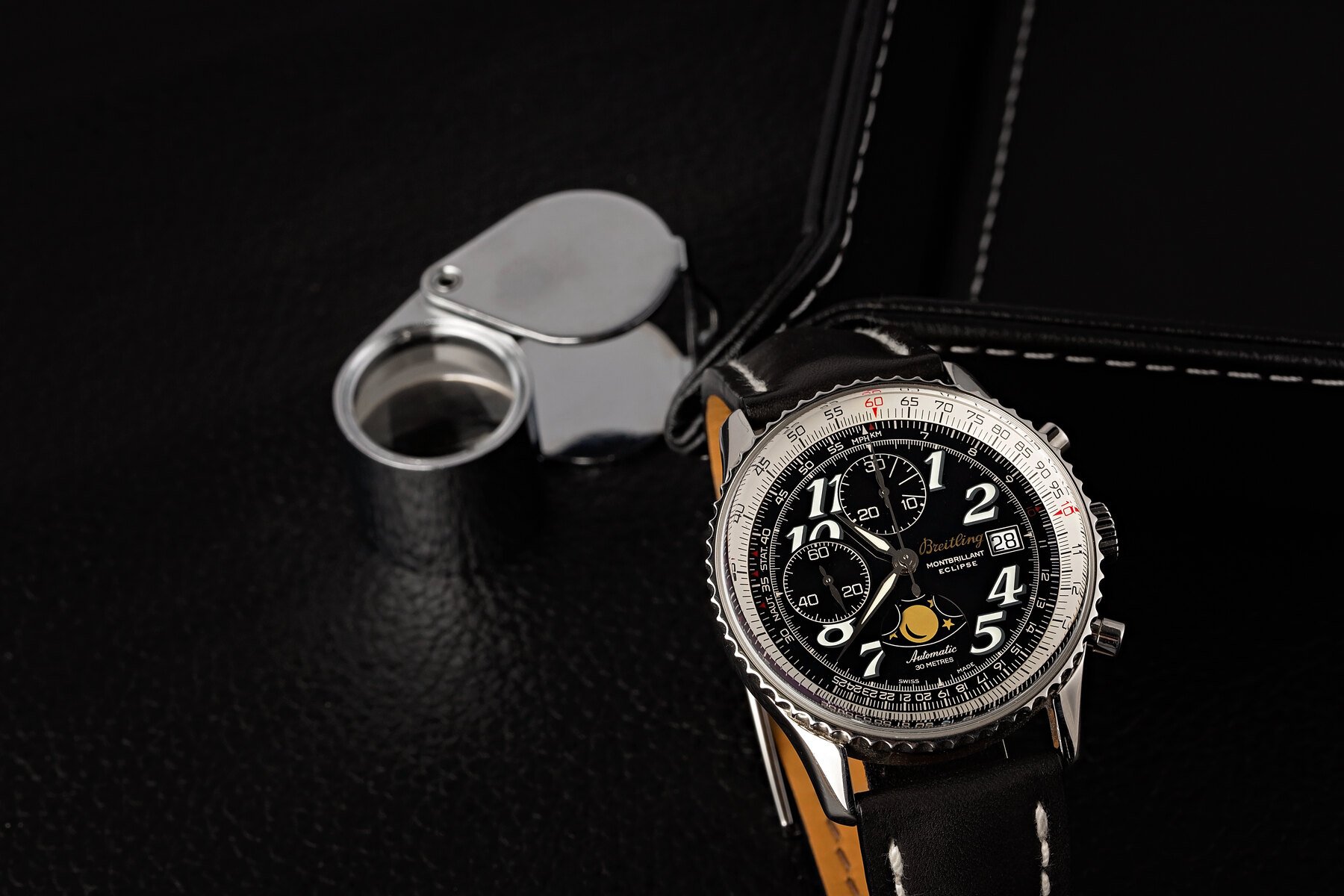
The world of luxury watches is dominated by names that have stood the test of time, and two giants that have consistently pushed the boundaries of horological excellence are Rolex and Breitling. Both brands have carved out unique niches in the industry, each with a storied past that continues to influence their present-day creations. Let's delve into the rich histories of these watchmaking titans.
Rolex: A Symbol of Status
The history of Rolex began in 1905 when Hans Wilsdorf founded the company in London. From its inception, Rolex set out to redefine the standards of timekeeping. The brand quickly gained recognition for its precision, earning the world's first chronometer certification for a wristwatch in 1910. This milestone set the stage for Rolex's relentless pursuit of excellence.
As the years progressed, Rolex continued to innovate, introducing groundbreaking features that would become industry standards. The launch of the Oyster case in 1926 marked a significant leap in water-resistant technology, while the introduction of the Perpetual rotor in 1931 revolutionized self-winding mechanisms. These innovations cemented Rolex's position as a leader in luxury watchmaking.
Today, Rolex stands as more than just a watchmaker; it's a cultural icon. The brand's timepieces have adorned the wrists of world leaders, explorers, and celebrities, further solidifying its status as the ultimate symbol of success and achievement in the horological world.
Breitling: A Pioneer in Aviation
The world of aviation has been intrinsically linked to the story of one of watchmaking's most renowned brands. This connection forms a crucial part of the Breitling history, which began in 1884 when Léon Breitling founded the company. From its inception, Breitling quickly established itself as a specialist in chronographs and precision timers, expertise that would prove invaluable as the age of aviation dawned in the early 20th century.
In 1915, Breitling introduced one of the world's first wrist chronographs with a separate push-piece, an innovation that would prove crucial for pilots. The brand's commitment to aviation was further cemented in 1952 with the launch of the legendary Navitimer, featuring a circular slide rule that allowed pilots to perform critical flight calculations.
Breitling's contributions to aviation timekeeping extend beyond wristwatches. The company has supplied precision cockpit clocks to major aircraft manufacturers and has been the official supplier to many of the world's air forces. This deep connection to aviation continues to influence Breitling's designs and technical innovations, making it the go-to brand for aviation enthusiasts and professionals alike.
Design Philosophy and Aesthetic Appeal
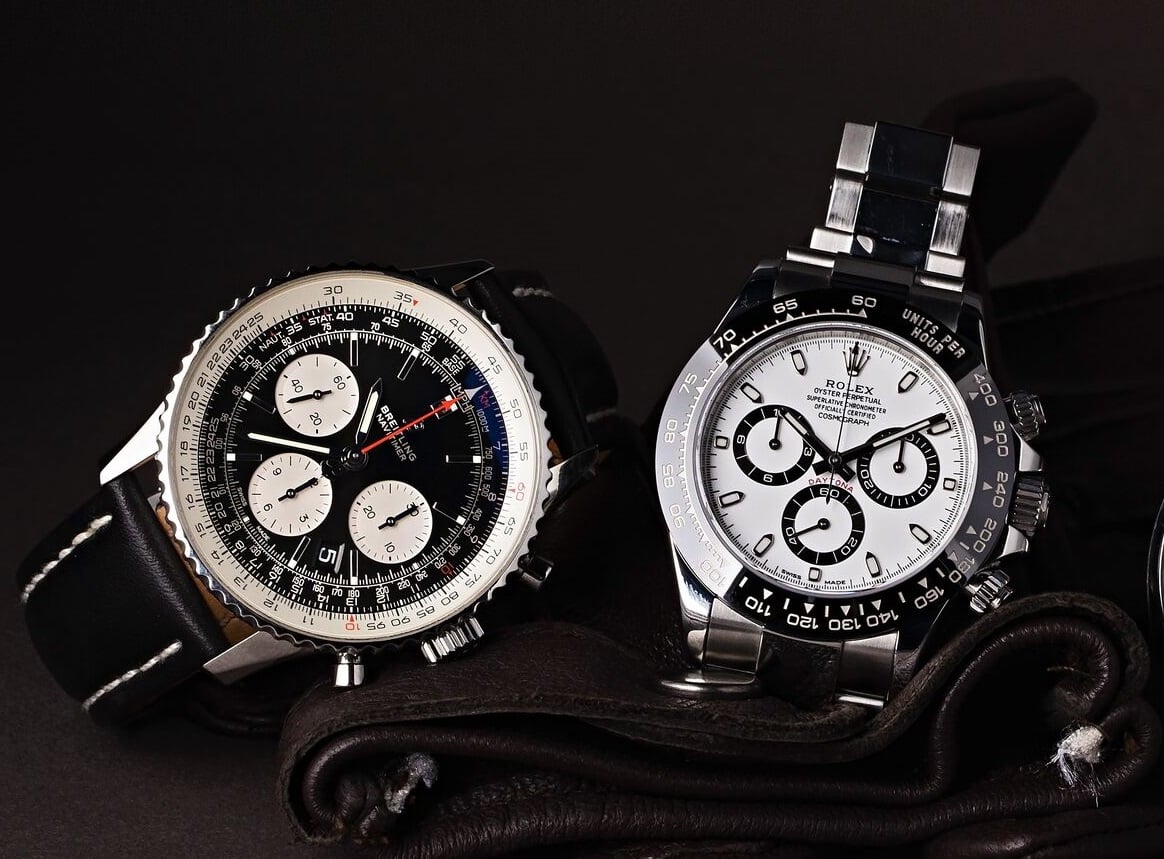
When it comes to luxury watches, design is not just about aesthetics; it's a reflection of a brand's identity, values, and target audience. Rolex and Breitling, while both renowned for their quality, have taken distinctly different paths in their design philosophies. These approaches have resulted in unique visual languages that speak volumes about each brand's ethos.
Rolex: Classic and Refined
Rolex's design philosophy is rooted in timeless elegance and understated sophistication. The brand's watches are instantly recognizable, thanks to their iconic elements that have remained largely unchanged for decades. This consistency is not a lack of innovation, but rather a testament to the enduring appeal of Rolex's design language.
At the heart of Rolex's aesthetic is the Oyster case, a cornerstone of the brand's identity since its introduction in 1926. This robust, waterproof case not only serves a functional purpose but also provides a distinctive visual signature. The fluted bezel, another Rolex hallmark, adds a touch of refinement while serving the practical purpose of allowing easy grip for adjustments.
Rolex dials are studies in clarity and balance. The brand's signature hands and hour markers, often crafted from precious metals and filled with luminous material, ensure excellent legibility while exuding luxury. The cyclops lens over the date window, introduced in 1953, has become another iconic Rolex feature, enhancing both functionality and visual appeal.
Breitling: Bold and Functional
In contrast to Rolex's understated elegance, Breitling embraces a bold, instrument-inspired aesthetic that reflects its aviation heritage. Breitling watches are designed to be functional tools first, with form following function in the most striking way possible.
Breitling's designs are characterized by large, highly legible dials packed with information. The brand's signature slide rule bezel, featured prominently on models like the Navitimer, is not just a design element but a functional tool for pilots. This commitment to utility extends to other features like chronograph subdials and tachymeter scales, all integrated into designs that are as visually impressive as they are practical.
The brand's use of materials also reflects its bold approach. While Breitling certainly employs precious metals, it's equally known for its use of high-tech materials like titanium and carbon fiber. These choices not only enhance durability but also contribute to the watches' modern, technical aesthetic.
Quality of Materials and Craftsmanship
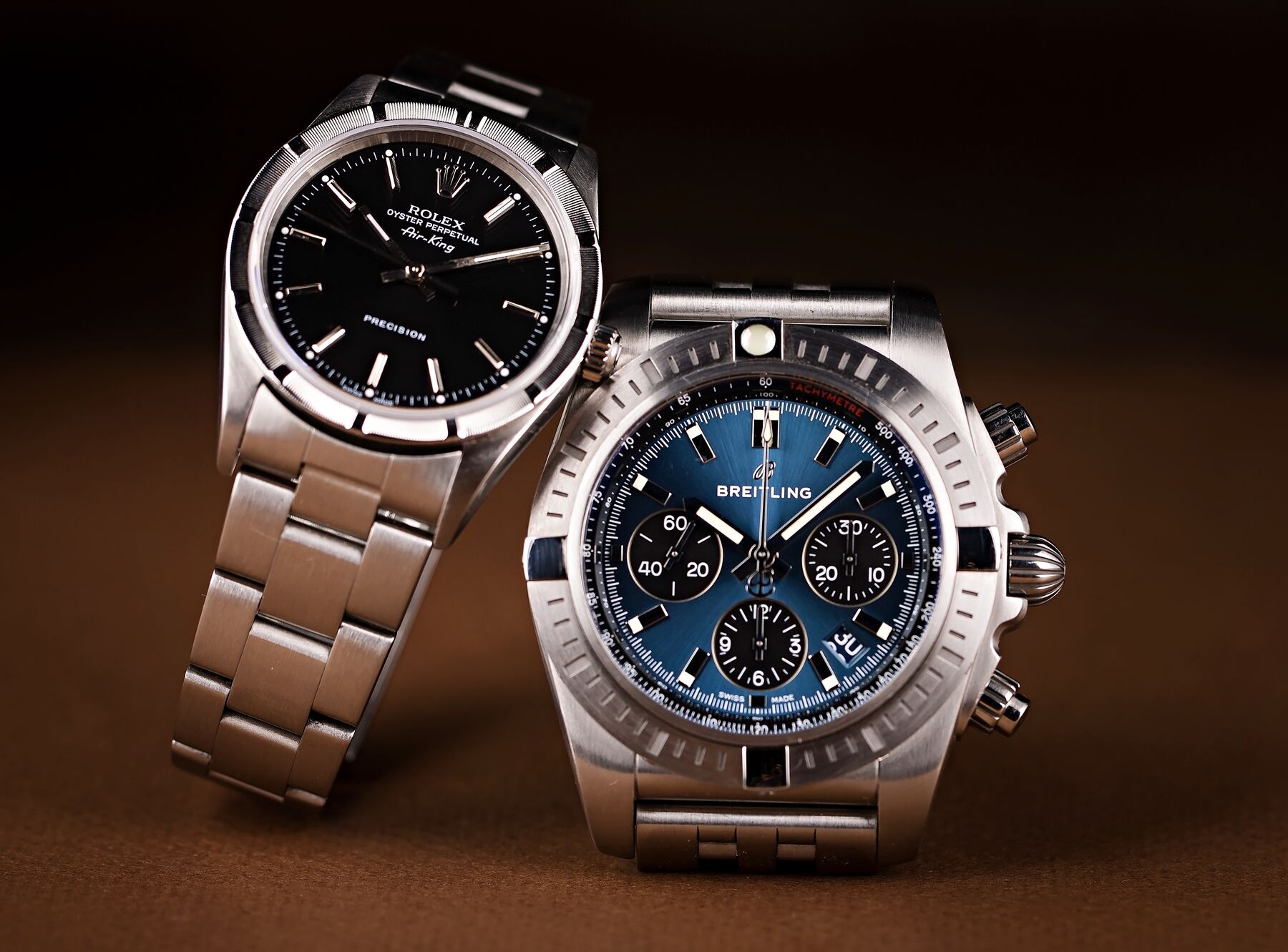
In the realm of luxury timepieces, the quality of materials used and the level of craftsmanship involved are paramount. Both Rolex and Breitling have built their reputations on exceptional quality, but each brand approaches this goal in its own unique way. Let's explore how these horological giants ensure that their timepieces meet the highest standards of luxury and durability.
Rolex: Precision Craftsmanship
Rolex's approach to materials and craftsmanship is characterized by an unwavering commitment to excellence and innovation. The brand is renowned for its use of 904L stainless steel, a material that's more resistant to corrosion and holds polish better than the 316L steel used by most watchmakers. This choice exemplifies Rolex's dedication to longevity and quality, even in its most basic models.
For its precious metal watches, Rolex goes a step further. The brand operates its own foundry, allowing it to create proprietary alloys like Everose gold, a unique 18-karat pink gold that maintains its luster over time. This level of vertical integration ensures that every component meets Rolex's exacting standards.
The craftsmanship involved in creating a Rolex watch is equally impressive. Each movement is assembled by hand, with tolerances measured in microns. The brand's signature Oyster cases are machined from solid blocks of metal and undergo rigorous testing to ensure water resistance. Even seemingly minor components, like the date disc, receive meticulous attention - Rolex's date wheels are made of solid brass and plated with gold.
Breitling: Engineering Mastery
Breitling's approach to materials and craftsmanship is deeply rooted in its aviation heritage, focusing on durability, reliability, and precision under extreme conditions. The brand utilizes a range of high-quality materials, from traditional stainless steel to innovative alloys and composites.
Like Rolex, Breitling uses 904L steel in many of its models, particularly those in the Professional line. This choice underscores the brand's commitment to corrosion resistance and durability. For its more specialized timepieces, Breitling has pioneered the use of materials like titanium and carbon fiber, offering exceptional strength-to-weight ratios that are particularly valuable in aviation contexts.
Breitling's craftsmanship is characterized by its focus on precision and reliability. The brand's movements, whether in-house or sourced from top Swiss manufacturers, undergo rigorous testing and adjustment. Breitling's chronographs, in particular, showcase the brand's engineering prowess, with complex mechanisms that ensure accuracy in timing functions.
The brand's attention to detail extends to every aspect of the watch. Breitling's cases are engineered to withstand extreme pressures and temperatures, with features like screw-down crowns and reinforced crystals. Even the brand's straps and bracelets are designed with durability in mind, often featuring innovative materials and secure clasping mechanisms.
Technology and Movement
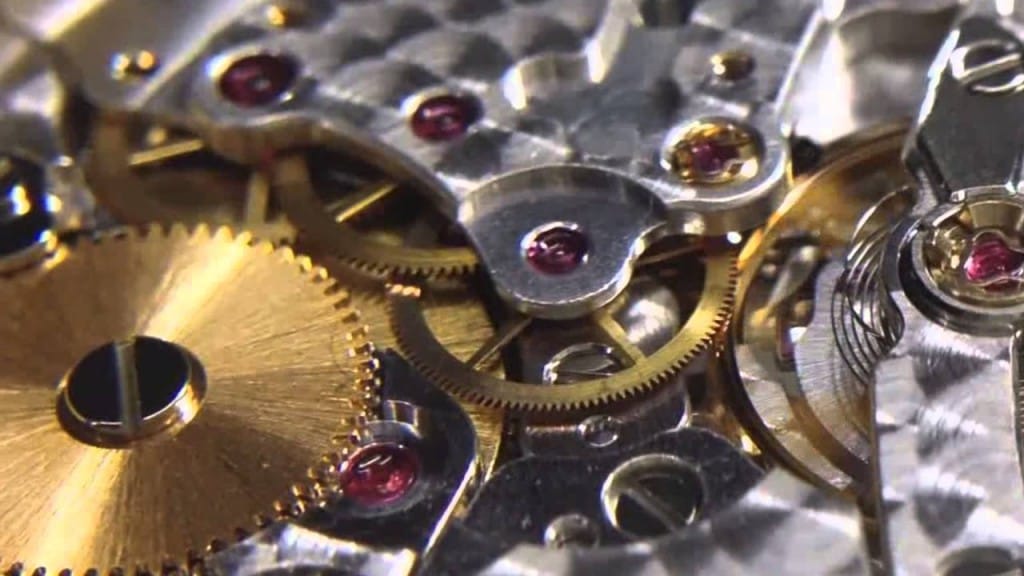
The heart of any luxury timepiece lies in its movement, the intricate mechanism that powers the watch and ensures its accuracy. Both Rolex and Breitling have made significant contributions to horological technology, each with its own approach to movement design and innovation. Let's explore the technological prowess behind these two watchmaking giants.
Rolex: In-House Mastery
Rolex's approach to movement technology is characterized by a relentless pursuit of precision, reliability, and innovation, all achieved through in-house development and production. This vertical integration allows Rolex to maintain complete control over the quality and performance of its movements.
At the core of Rolex's technological prowess is its Perpetual rotor, an innovation introduced in 1931 that revolutionized self-winding mechanisms. This system, continuously refined over the decades, ensures efficient winding of the mainspring through the natural movements of the wearer's wrist. Rolex has further enhanced this technology with the introduction of the Parachrom hairspring, made from a proprietary alloy that's highly resistant to temperature variations and magnetic fields.
Another significant innovation is Rolex's Paraflex shock absorbers. This system provides superior protection against shocks and impacts, enhancing the durability of the movement. Combined with Rolex's rigorous testing procedures, which include simulating years of wear in just a few weeks, these technologies ensure that Rolex movements maintain their accuracy and reliability over time.
Rolex's commitment to chronometric precision is evident in its Superlative Chronometer certification. This in-house certification, which goes beyond the standard COSC testing, ensures that every Rolex watch meets stringent accuracy standards of -2/+2 seconds per day.
Breitling: Chronometer Precision
Breitling's approach to movement technology reflects its heritage in precision timekeeping and its commitment to chronometric excellence. While the brand has increasingly focused on developing in-house movements, it also maintains partnerships with top Swiss movement manufacturers to ensure the highest levels of quality and innovation.
Central to Breitling's technological identity is its commitment to chronometer certification. Every Breitling watch, regardless of whether it uses an in-house or third-party movement, is certified by the Swiss Official Chronometer Testing Institute (COSC). This certification guarantees that the movement meets stringent accuracy standards, typically within -4/+6 seconds per day.
Breitling's in-house movements, particularly its B01 caliber, showcase the brand's technological capabilities. This column-wheel chronograph movement, introduced in 2009, features a vertical clutch system that ensures precise start and stop functions and allows for extended use of the chronograph without affecting timekeeping accuracy.
The brand has also made significant strides in quartz technology. Breitling's SuperQuartz™ movements, found in its Professional line, are thermocompensated for superior accuracy, achieving precision ten times greater than standard quartz movements.
Market Position and Audience
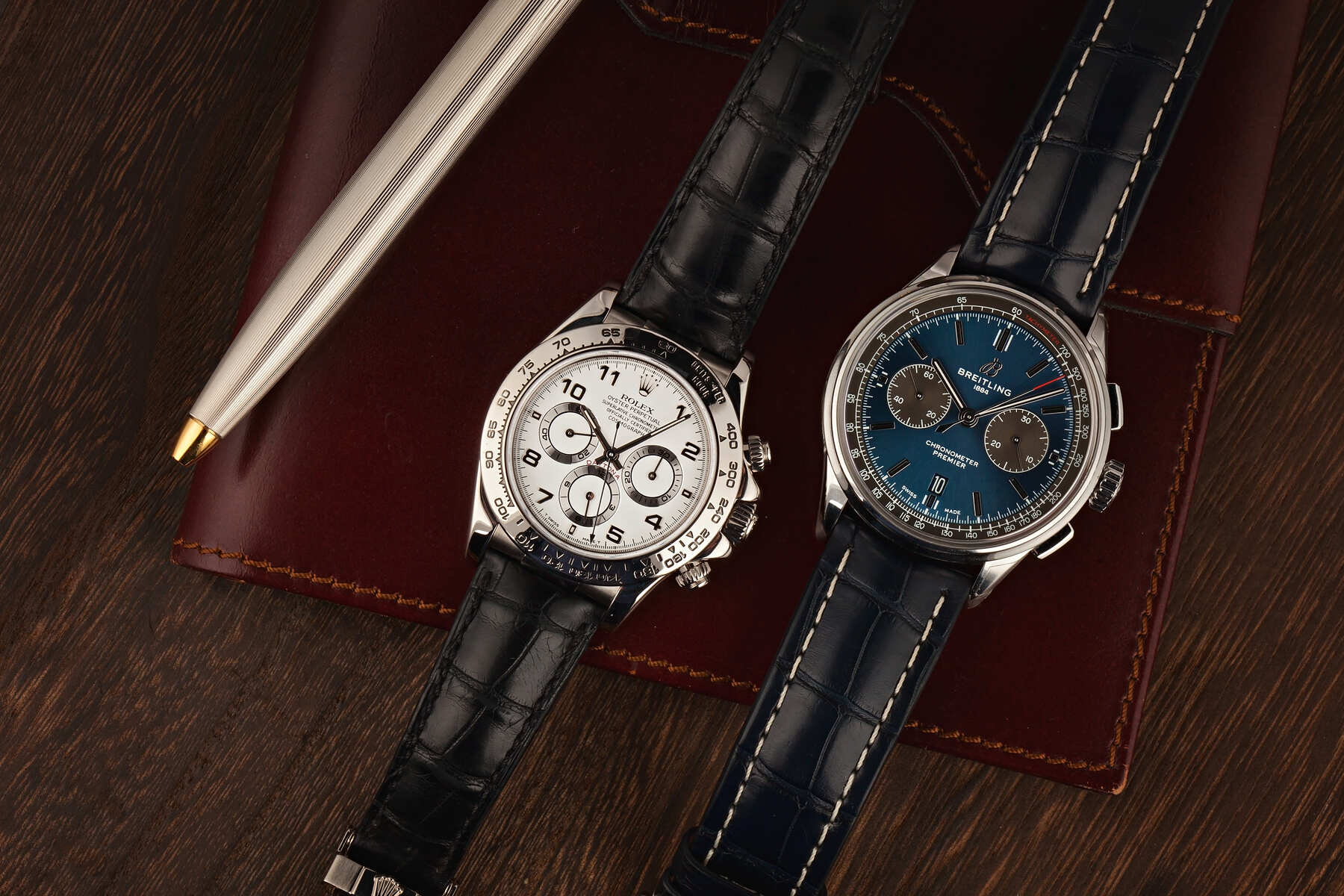
In the competitive landscape of luxury watchmaking, both Rolex and Breitling have carved out distinct market positions that reflect their unique histories, design philosophies, and brand identities. Understanding these positions and the audiences they attract provides valuable insight into the appeal of these horological powerhouses.
Rolex: Universal Appeal and Prestige
Rolex occupies a unique position in the luxury watch market, straddling the line between high-end luxury and broad aspirational appeal. The brand has successfully cultivated an image of universal prestige that transcends specific professions or lifestyles, making it appealing to a diverse range of consumers.
At its core, Rolex's market position is built on the perception of the brand as the ultimate symbol of success and achievement. This positioning has made Rolex watches coveted status symbols among professionals across various fields, from business executives and lawyers to doctors and athletes. The brand's association with excellence and precision also attracts those who appreciate fine craftsmanship and engineering.
Rolex's audience is notably broad, encompassing both seasoned watch enthusiasts and those new to the world of luxury timepieces. For many, a Rolex represents a milestone purchase, often marking a significant life achievement or career progression. This aspirational quality has helped Rolex maintain its position as one of the most recognized and desired luxury brands globally.
Collectors form another significant segment of Rolex's audience. The brand's history of innovation, limited production of certain models, and the potential for value appreciation make Rolex watches highly sought after in the collecting community. Vintage Rolex watches, in particular, have seen substantial increases in value, further cementing the brand's position as a sound investment.
Breitling: Specialized Appeal
In contrast to Rolex's broad appeal, Breitling has cultivated a more specialized market position, closely tied to its heritage in aviation and technical timekeeping. This focused approach has allowed Breitling to establish itself as the go-to brand for a specific subset of watch enthusiasts and professionals.
Breitling's core audience consists of individuals with a passion for aviation, both professionals and enthusiasts. The brand's long-standing association with pilots and aircraft manufacturers has made it a natural choice for those in the aviation industry. This connection extends beyond just pilots to include aerospace engineers, air traffic controllers, and aviation enthusiasts who appreciate the technical capabilities and aviation-inspired design of Breitling watches.
Beyond the aviation niche, Breitling has successfully positioned itself as a brand for adventure seekers and outdoor enthusiasts. The robustness and functionality of Breitling watches, particularly models in the Professional line, appeal to those who lead active lifestyles or work in demanding environments. This includes divers, mountaineers, and other outdoor professionals who require reliable and durable timekeeping instruments.
Breitling also attracts watch collectors who appreciate technical innovation and chronograph complications. The brand's history of developing precision chronographs and its more recent focus on in-house movements have made it a favorite among horological enthusiasts who value both heritage and innovation.
Resale Value and Investment Potential
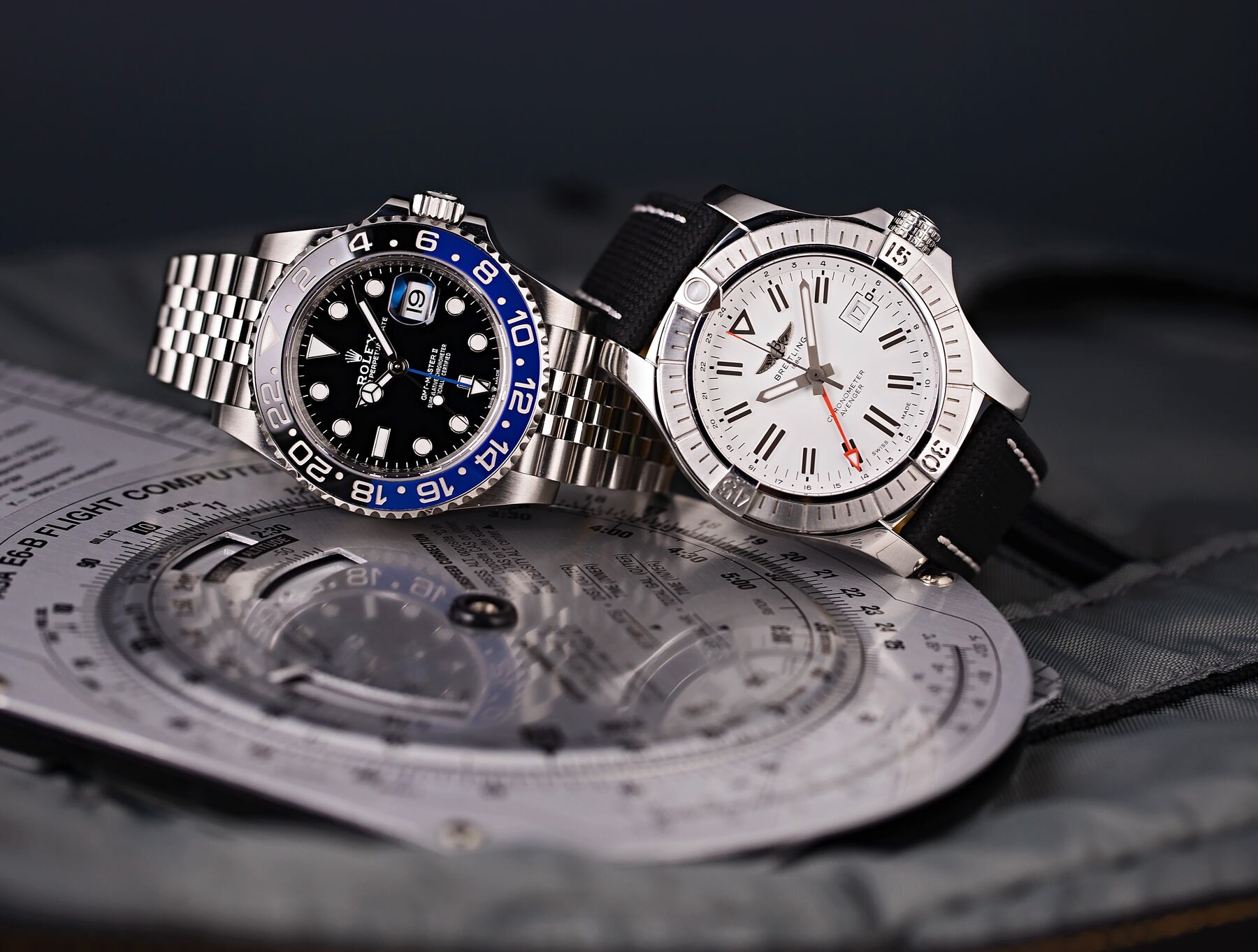
In the world of luxury watches, the concepts of resale value and investment potential have become increasingly important to buyers. Both Rolex and Breitling have established strong reputations in this regard, albeit with some notable differences. Let's explore how these brands fare in the secondary market and their potential as investments.
Rolex: Market Leader in Value Retention
Rolex stands out as a powerhouse when it comes to resale value and investment potential in the luxury watch market. The brand's reputation for quality, its carefully managed production, and its enduring popularity have created a perfect storm for value retention and appreciation.
One of the key factors contributing to Rolex's strong resale value is the brand's consistent approach to design and model evolution. Many Rolex models have remained largely unchanged for decades, with only subtle updates. This continuity creates a sense of timelessness and helps maintain demand for both new and vintage models.
Rolex's production strategy also plays a crucial role. The brand is known for limiting the supply of its most popular models, which often leads to waiting lists at authorized dealers. This scarcity in the primary market drives up prices in the secondary market, particularly for stainless steel sports models like the Submariner, Daytona, and GMT-Master II.
The investment potential of certain Rolex models has been nothing short of remarkable. For instance, the Rolex Daytona ref. 116500LN, introduced in 2016 at a retail price of around $12,400, has seen its market value more than double in just a few years. Vintage Rolex models have shown even more dramatic appreciation, with rare references fetching astronomical prices at auctions.
It's important to note, however, that not all Rolex models appreciate equally. When considering the best Rolex for investment, sports models and certain professional series watches, such as the Submariner and Daytona, tend to perform better in the secondary market compared to dress watches or less popular references. This is due to their consistent demand and potential for value appreciation. Nonetheless, even Rolex models that don't significantly appreciate tend to hold their value well, making them a relatively safe store of value.
Breitling: Consistent but Niche
While Breitling doesn't command the same level of investment fervor as Rolex, the brand has established a solid reputation for value retention, particularly within its niche of aviation and professional watches.
Breitling's resale value is generally strong, with many models retaining a significant portion of their original retail price in the secondary market. This stability is largely due to the brand's reputation for quality, its COSC-certified movements, and its strong connection to the aviation community.
Certain Breitling models have shown particularly good investment potential. The Navitimer, Breitling's flagship model, has a dedicated following and tends to hold its value well. Limited edition models and those with historical significance, such as vintage Navitimers or the re-edition of the Breitling Top Time, have also shown appreciation potential.
However, it's important to note that Breitling's market is more specialized than Rolex's. While this focused appeal can drive strong demand and prices for certain models, it also means that Breitling watches generally don't see the same broad-based appreciation as Rolex.
When comparing Breitling's investment potential to Rolex, it's clear that Rolex has a significant edge in terms of overall market performance and consistency of appreciation. However, Breitling offers strong potential within its niche, particularly for aviation enthusiasts and collectors of technical watches.
It's worth noting that while Breitling may not match Rolex in terms of overall investment performance, it often provides better value for money in the primary market. This can make Breitling an attractive option for buyers who prioritize getting a high-quality Swiss luxury watch at a more accessible price point, with the potential for stable value retention.
Iconic Model Comparisons
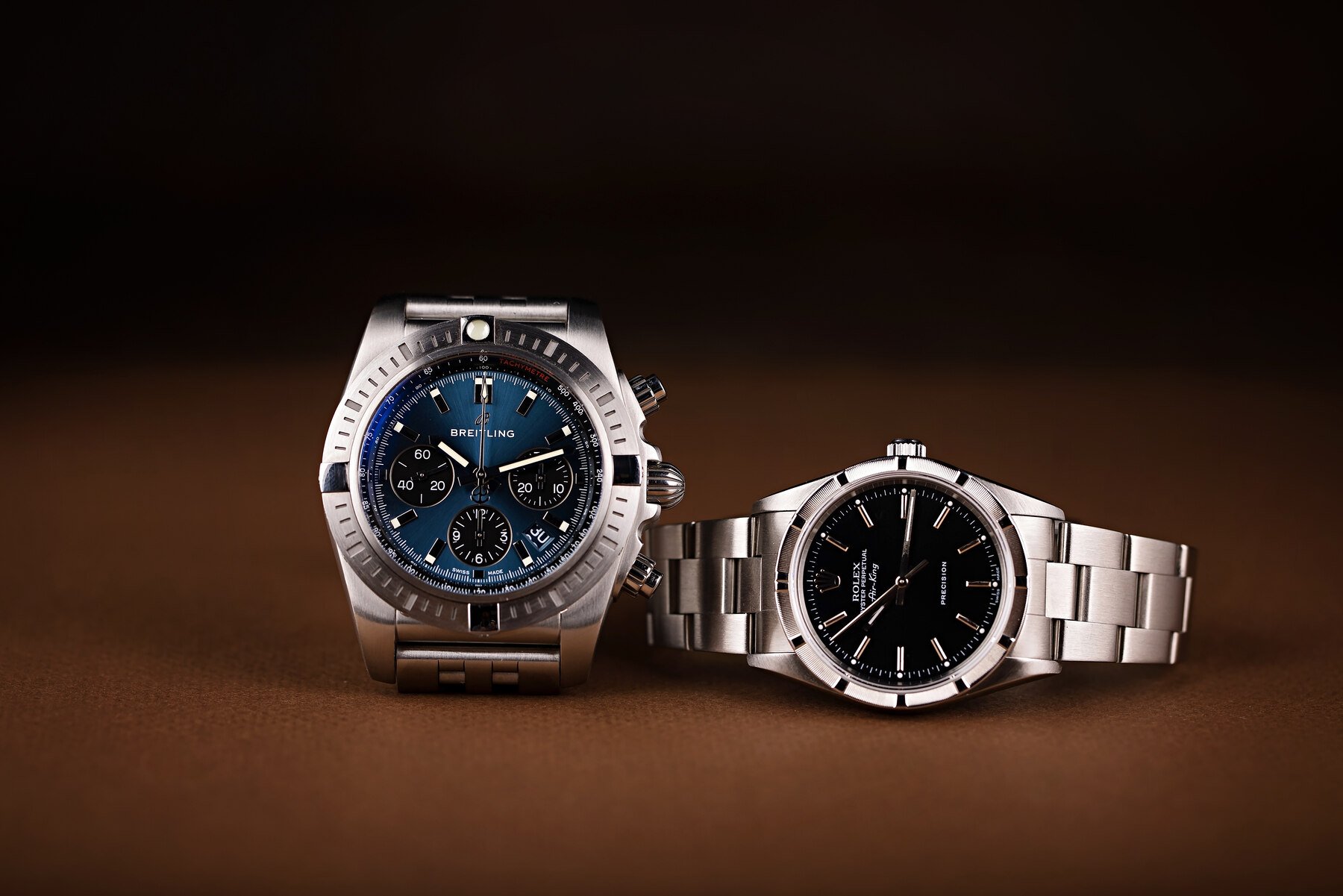
To truly understand the differences and similarities between Rolex and Breitling, it's enlightening to compare some of their most iconic models. These comparisons not only highlight each brand's strengths but also provide insight into their design philosophies and target markets.
Rolex Submariner vs. Breitling Superocean
The Rolex Submariner and the Breitling Superocean represent each brand's approach to the classic dive watch, a category that has become increasingly popular beyond just professional divers.
The Rolex Submariner, introduced in 1953, is arguably the most famous dive watch in the world. Its design has remained largely unchanged over the decades, a testament to its timeless appeal. The Submariner features a 41mm case (in the latest iteration), a unidirectional rotating bezel, and water resistance to 300 meters. The watch is powered by Rolex's in-house caliber 3230, known for its precision and reliability.
While less famous than the Submariner, the Breitling Superocean has a loyal following among dive enthusiasts. The latest models feature larger cases (42mm to 46mm) and bolder designs, reflecting Breitling's more modern aesthetic. The Superocean boasts impressive water resistance up to 1000 meters in some models, appealing to professional divers and those who appreciate extreme capabilities.
In terms of market reception, the Submariner has broader appeal and stronger brand recognition, often seen as a status symbol beyond diving circles. The Superocean, while highly respected, has a more niche appeal, often favored by those who appreciate its robust build and distinctive design.
Rolex Daytona vs. Breitling Chronomat
The Rolex Daytona and Breitling Chronomat are both iconic chronographs, each with a rich history and devoted following.
Introduced in 1963, the Rolex Daytona has become one of the most sought-after watches in the world. Its 40mm case houses Rolex's in-house chronograph movement, the caliber 4130. The Daytona's clean dial layout, with its signature three subdials, has become a benchmark in chronograph design.
The Breitling Chronomat, first launched in 1984, has a more recent history but has quickly become a cornerstone of the brand's collection. The latest models feature a 42mm case and are powered by Breitling's in-house B01 movement. The Chronomat's design is more complex than the Daytona's, with a busier dial and the option of Breitling's signature rider tabs on the bezel.
In terms of performance, both watches offer excellent chronograph functionality. The Daytona is renowned for its precision and reliability, while the Chronomat is appreciated for its robustness and versatility.
Market-wise, the Daytona has achieved almost mythical status, with waiting lists for new models often stretching for years. The Chronomat, while popular, is more readily available and offers a compelling alternative for those seeking a high-quality Swiss chronograph.
Rolex GMT-Master II vs. Breitling Navitimer
The Rolex GMT-Master II and the Breitling Navitimer are both celebrated for their ties to aviation, though they approach this heritage in different ways.
Evolved from the original GMT-Master introduced in 1954, the Rolex GMT-Master II is designed for international travelers. Its key feature is the ability to display three time zones simultaneously. The latest models feature a 40mm case, a bidirectional rotating bezel with a 24-hour scale, and Rolex's caliber 3285 movement.
Breitling's Navitimer, first introduced in 1952, is instantly recognizable by its circular slide rule bezel. This feature, while less practical in the age of digital calculators, remains a hallmark of the watch's design and a testament to its aviation heritage. The Breitling Navitimer typically features a larger case (43mm to 46mm) and is powered by the brand's in-house B01 movement in many models.
In terms of functionality, the GMT-Master II is more focused on time zone tracking, making it popular among frequent travelers and pilots. The Navitimer, with its slide rule, offers a broader range of calculations but requires more knowledge to use effectively.
The GMT-Master II, particularly models with two-tone bezels like the "Rolex Pepsi" and "Rolex Batman," have become highly sought after, often commanding premiums on the secondary market. The Navitimer, while not reaching the same levels of demand, has a dedicated following, particularly among aviation enthusiasts and those who appreciate its unique aesthetic.
Price Range and Accessibility
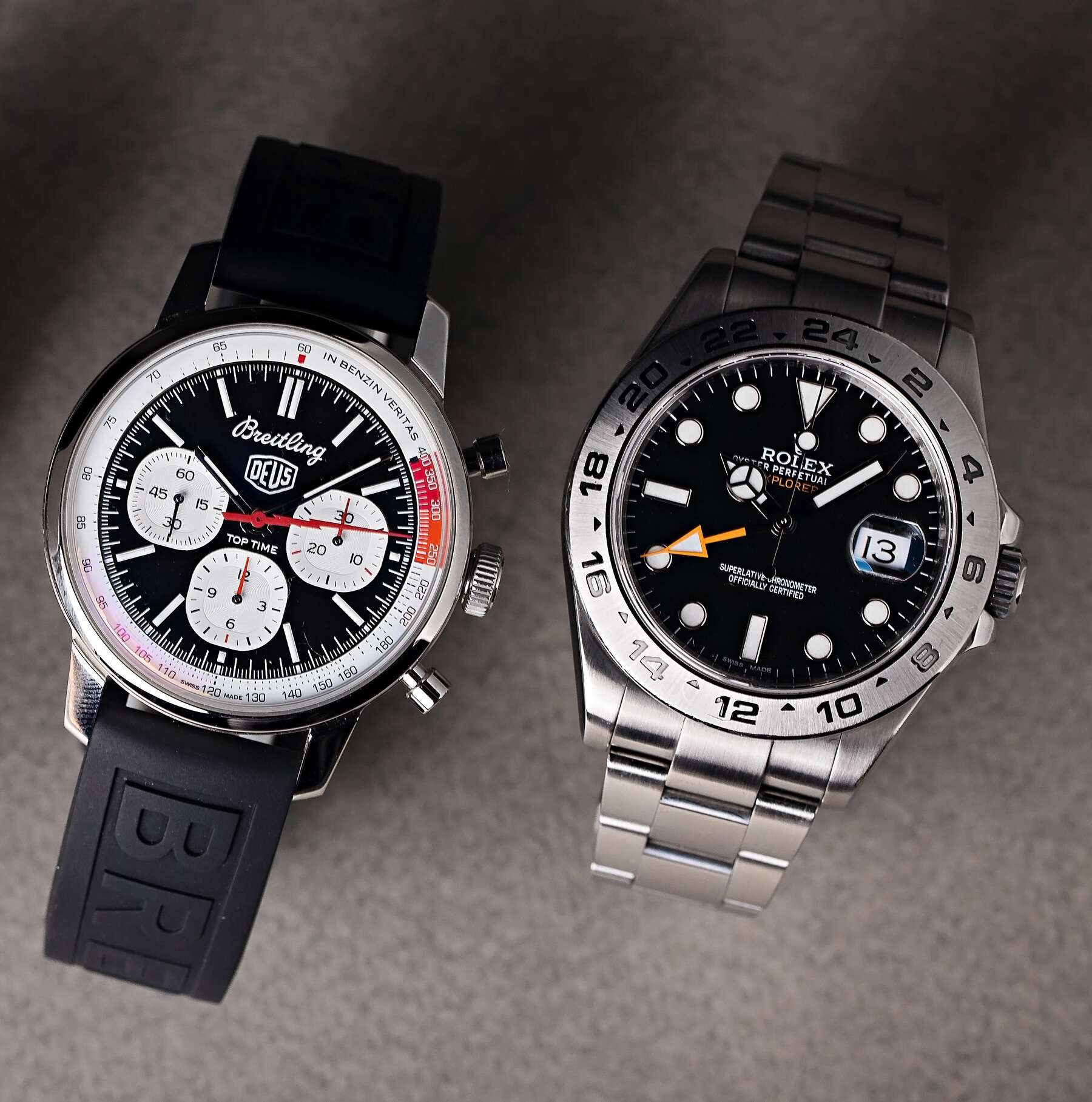
Understanding the price ranges of Rolex and Breitling watches is crucial for potential buyers, as it not only reflects the positioning of these brands in the luxury market but also impacts their accessibility to different segments of watch enthusiasts.
Rolex: Luxury at a Premium
Rolex has positioned itself firmly in the high-end luxury segment, with prices that reflect its status as one of the world's most prestigious watch brands. The price range for new Rolex watches is quite broad, catering to different levels of luxury consumers.
For new, non-discontinued Rolex models:
- Entry-level models like the Oyster Perpetual start around $5,900 to $6,500.
- Mid-range models such as the Datejust or Explorer typically range from $7,000 to $14,000.
- Popular sports models like the Submariner or GMT-Master II are priced between $9,500 and $40,000, depending on the specific model and materials used.
- High-end models and those crafted from precious metals can exceed $50,000, with some special editions reaching well into six figures.
In the pre-owned market, Rolex watches often command prices close to or even exceeding their retail values, especially for highly sought-after models:
- Vintage Rolex watches can range from $3,000 for less popular models to over $100,000 for rare or historically significant pieces.
- Recent pre-owned models of popular lines like the Submariner or Daytona often sell for 20-50% above their retail prices due to high demand and limited availability.
It's worth noting that the high demand for certain Rolex models has created a situation where the retail price is often lower than the market price, leading to long waiting lists at authorized dealers.
Breitling: High-End Accessibility
Breitling positions itself as a luxury brand, but generally at a more accessible price point compared to Rolex. This pricing strategy allows Breitling to appeal to a broader range of watch enthusiasts while still maintaining its status as a high-end Swiss watchmaker.
For new, non-discontinued Breitling models:
- Entry-level quartz models in the Colt or Aerospace lines start around $3,000 to $4,500.
- Mid-range automatic models like the Superocean or Avenger typically range from $4,500 to $8,000.
- High-end models and chronographs such as the Navitimer or Chronomat are generally priced between $8,000 and $20,000.
- Limited editions and models crafted from precious metals can exceed $25,000, though rarely go above $50,000.
In the pre-owned market, Breitling watches generally offer good value:
- Vintage Breitling watches can be found from $2,000 for less popular models, with rare or historically significant pieces reaching up to $30,000 or more.
- Recent pre-owned models typically sell for 20-30% less than their retail prices, making them an attractive option for buyers looking for value.
Breitling's pricing strategy makes its watches more immediately accessible to a wider audience. While they may not have the same investment potential as Rolex, Breitling offers the opportunity to own a luxury Swiss watch at a more approachable price point.
Rolex vs Breitling: And the Winner Is...
As we've explored the worlds of Rolex and Breitling, it's clear that both brands offer exceptional quality and rich histories in the realm of luxury watchmaking. Each brand, however, caters to different aspects of the market and appeals to varying preferences among watch enthusiasts.
Rolex stands out for its timeless designs, unparalleled brand recognition, and strong investment potential. The brand's commitment to incremental improvements while maintaining iconic designs has created a lineup of watches that are instantly recognizable and highly sought after. Rolex's market position as the ultimate symbol of success and achievement makes it appealing to a broad range of consumers, from first-time luxury watch buyers to seasoned collectors.
Breitling, on the other hand, shines with its bold designs, technical innovations, and strong ties to aviation. The brand's focus on chronographs and professional-grade timepieces has earned it a dedicated following among aviation enthusiasts and those who appreciate robust, feature-rich watches. Breitling's more accessible price point also makes it an attractive option for those looking to enter the world of luxury Swiss watches.
When choosing between Rolex and Breitling, consider your personal style, functional needs, and long-term value expectations. If you're drawn to classic, understated elegance and the potential for value appreciation, Rolex might be the ideal choice. If you prefer bold, technically advanced timepieces with a strong connection to aviation and adventure, Breitling could be the perfect fit.
Ultimately, both Rolex and Breitling offer exceptional timepieces that represent the pinnacle of Swiss watchmaking. Your choice between these two horological giants should align with your individual preferences, lifestyle, and the statement you want to make with your wrist wear. Whichever you choose, you'll be wearing a piece of watchmaking history and craftsmanship that will stand the test of time.
With over two decades of experience in the luxury watch industry, the Bob's Watches Editorial Team stands at the forefront of watch expertise and insight. Our team, composed of seasoned watch enthusiasts, skilled horologists, and knowledgeable industry insiders, is dedicated to bringing you the latest and most accurate information in the world of luxury timepieces. We pride ourselves on our meticulous attention to detail and our unwavering commitment to authenticity. Our editorial content is a reflection of our passion for luxury watches and our dedication to providing our readers with comprehensive, unbiased, and up-to-date information. Our expertise spans a wide range of topics, including in-depth reviews of the latest models, historical retrospectives of iconic timepieces, and insightful analyses of market trends. We are also renowned for our detailed guides on watch maintenance and investment advice, making us a trusted resource for both seasoned collectors and new enthusiasts alike. As thought leaders in the watch industry, we understand the importance of staying ahead of the curve. That's why we continually update our knowledge and skills, ensuring that our readers receive the most current and relevant information. Whether you're seeking advice on your next luxury watch purchase or looking to deepen your understanding of watch craftsmanship, the Bob's Watches Editorial Team is here to guide you.